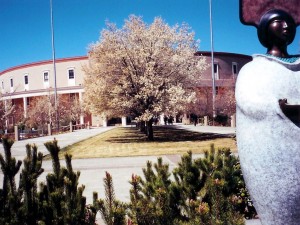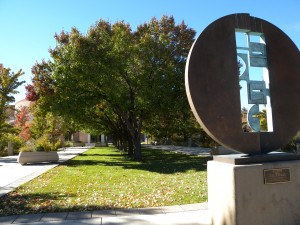‘Santa Fe’ Category
» posted on Monday, November 5th, 2012 by Linda Lou Burton
Simplicity in Symbolism
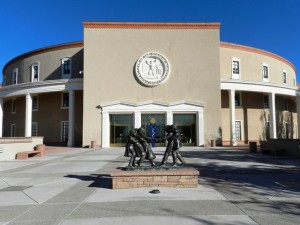 Linda Burton posting from Santa Fe, New Mexico – Clean modern lines reflecting ancient traditions – how do you combine that into a stunning and meaningful setting appropriate for the business of the state? New Mexico is one of the newer states (47th in 1912) and now has one of the newer capitol buildings (dedicated 1966). It also has the oldest – the Palace of Governors (1609) still stands on the north side of the Plaza, as the state museum. In between, New Mexico had an elaborate Victorian capitol (1886) which citizens called “audacious” and a traditional capitol with a silver dome (1900) which was often criticized as not being appropriate for the state; in 1950 the dome was removed. Building #4 seems to have done the trick for New Mexico; its New Mexico Territorial style – that unique combo of Greek Revival and Pueblo adobe – fits the ambiance, and the sensibilities, of the capital city. When viewed from above you can see that the unusual circular building resembles the Zia Sun Symbol, with four entrance wings protruding from the main center. That Zia symbol represents values important to the people of New Mexico. » read more
Linda Burton posting from Santa Fe, New Mexico – Clean modern lines reflecting ancient traditions – how do you combine that into a stunning and meaningful setting appropriate for the business of the state? New Mexico is one of the newer states (47th in 1912) and now has one of the newer capitol buildings (dedicated 1966). It also has the oldest – the Palace of Governors (1609) still stands on the north side of the Plaza, as the state museum. In between, New Mexico had an elaborate Victorian capitol (1886) which citizens called “audacious” and a traditional capitol with a silver dome (1900) which was often criticized as not being appropriate for the state; in 1950 the dome was removed. Building #4 seems to have done the trick for New Mexico; its New Mexico Territorial style – that unique combo of Greek Revival and Pueblo adobe – fits the ambiance, and the sensibilities, of the capital city. When viewed from above you can see that the unusual circular building resembles the Zia Sun Symbol, with four entrance wings protruding from the main center. That Zia symbol represents values important to the people of New Mexico. » read more
» posted on Saturday, November 3rd, 2012 by Linda Lou Burton
The Air and The Waters
 Linda Burton posting from Santa Fe, New Mexico – “The air.” That has been the answer by many as I have asked the question “What do you like best about Santa Fe?” Santa Fe is the country’s highest capital city with an elevation of 7,000 feet, give or take a few depending on which side of town you’re on. It is high desert country, with about 320 days of sunshine a year. It sits at the foot of the Sangre de Cristo Mountains, that sub-range of the Rockies that extends 240 miles from Colorado into New Mexico. Near Taos to the north is Wheeler Peak, New Mexico’s highest point, at 13,161 feet; just outside Santa Fe is Truchas Peak, at 13,102. So here you have a pretty place where the sun almost always
Linda Burton posting from Santa Fe, New Mexico – “The air.” That has been the answer by many as I have asked the question “What do you like best about Santa Fe?” Santa Fe is the country’s highest capital city with an elevation of 7,000 feet, give or take a few depending on which side of town you’re on. It is high desert country, with about 320 days of sunshine a year. It sits at the foot of the Sangre de Cristo Mountains, that sub-range of the Rockies that extends 240 miles from Colorado into New Mexico. Near Taos to the north is Wheeler Peak, New Mexico’s highest point, at 13,161 feet; just outside Santa Fe is Truchas Peak, at 13,102. So here you have a pretty place where the sun almost always 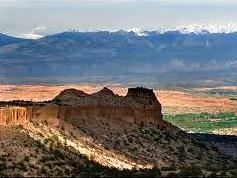 shines, it doesn’t get too hot or too cold, and the air is clean. Very attractive! Santa Fe air has been attracting people for thousands of years; it appears to have both an inspirational and a healing effect on those who come. John Gaw Meem (the architect) came to recover from tuberculosis in 1920, where he met Carlos Vierra (the artist) at Sunmount Sanatorium (we’ve already talked about them). Sunmount was in business from the early 1900’s to that point in time when medication became available for the disease; it offered patients clean dry air and a chance to rest, far from the pressures of the madding crowd. » read more
shines, it doesn’t get too hot or too cold, and the air is clean. Very attractive! Santa Fe air has been attracting people for thousands of years; it appears to have both an inspirational and a healing effect on those who come. John Gaw Meem (the architect) came to recover from tuberculosis in 1920, where he met Carlos Vierra (the artist) at Sunmount Sanatorium (we’ve already talked about them). Sunmount was in business from the early 1900’s to that point in time when medication became available for the disease; it offered patients clean dry air and a chance to rest, far from the pressures of the madding crowd. » read more
» posted on Thursday, November 1st, 2012 by Linda Lou Burton
A Petri Dish of Culture
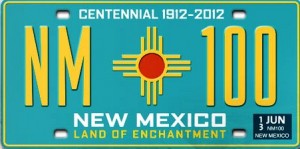 Linda Burton posting from Santa Fe, New Mexico – Everybody loves a party, and there’s been a big one going on this year in New Mexico. It’s a Centennial year, celebrating New Mexico’s 100 years of statehood; on January 6, 1912 it became the 47th state. Festivals and events have been happening from one corner of the state to the other; there was even a Culture Pass for sale! It cost $25 and offered access to the 8 museums and 6 monuments that fall within the aegis of New Mexico’s Department of Cultural Affairs. http://www.newmexicoculture.org/index.php . This department, headquartered in Santa Fe, was created back in 1978 and, according to its website, is dedicated to “preserving and celebrating the cultural integrity and diversity of our state.” It oversees a broad range of New Mexico’s arts and cultural heritage agencies (15 divisions);
Linda Burton posting from Santa Fe, New Mexico – Everybody loves a party, and there’s been a big one going on this year in New Mexico. It’s a Centennial year, celebrating New Mexico’s 100 years of statehood; on January 6, 1912 it became the 47th state. Festivals and events have been happening from one corner of the state to the other; there was even a Culture Pass for sale! It cost $25 and offered access to the 8 museums and 6 monuments that fall within the aegis of New Mexico’s Department of Cultural Affairs. http://www.newmexicoculture.org/index.php . This department, headquartered in Santa Fe, was created back in 1978 and, according to its website, is dedicated to “preserving and celebrating the cultural integrity and diversity of our state.” It oversees a broad range of New Mexico’s arts and cultural heritage agencies (15 divisions); 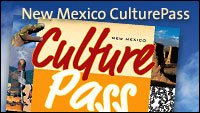 there are 500 employees and about a thousand volunteers who put in 70,000 hours annually. Every year more than $2 million goes directly to New Mexico’s cultural activities to fund arts and cultural programs; over three million people are served. But back to that Culture Pass, and the doors it would open. » read more
there are 500 employees and about a thousand volunteers who put in 70,000 hours annually. Every year more than $2 million goes directly to New Mexico’s cultural activities to fund arts and cultural programs; over three million people are served. But back to that Culture Pass, and the doors it would open. » read more
» posted on Tuesday, October 30th, 2012 by Linda Lou Burton
They Get It
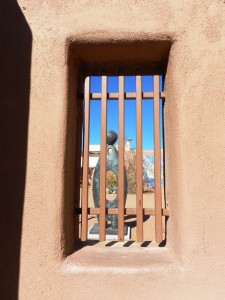 Linda Burton posting from Santa Fe, New Mexico – “There is no other place in the country where cultures meet, and blend, like they do here.” So said Maria, explaining to me why she loves Santa Fe so much. My first question to her was “Why are all the buildings brown?” She answered that the southwest adobe style was the heritage of centuries past. Maria, a Greek transplant from Chicago, laughed as she pointed out her dark hair and skin tones. “People think I’m Spanish,” she continued, “and because I speak Spanish fluently, I fit in here from the first day. I get what this city is all about. Some people don’t. I can see it on their face; they seem puzzled by what they interpret as ‘sameness.’ To me, it is a love and respect for the land, and for the traditions of the past. As a child I visited my grandparent’s farm in Greece; they lived simply and wasted nothing. They used what they had, and that’s what Native Americans did here centuries ago. They had sand and clay and water and straw; that’s what they used to make their houses. Their houses were earth-toned because they were made of earth! That tradition is held today in Santa Fe. And besides, it’s the law.” The law? After my conversation with Maria, I did some research into the city’s history. I found The Ordinance of 1957, and I learned about John Gaw Meem. » read more
Linda Burton posting from Santa Fe, New Mexico – “There is no other place in the country where cultures meet, and blend, like they do here.” So said Maria, explaining to me why she loves Santa Fe so much. My first question to her was “Why are all the buildings brown?” She answered that the southwest adobe style was the heritage of centuries past. Maria, a Greek transplant from Chicago, laughed as she pointed out her dark hair and skin tones. “People think I’m Spanish,” she continued, “and because I speak Spanish fluently, I fit in here from the first day. I get what this city is all about. Some people don’t. I can see it on their face; they seem puzzled by what they interpret as ‘sameness.’ To me, it is a love and respect for the land, and for the traditions of the past. As a child I visited my grandparent’s farm in Greece; they lived simply and wasted nothing. They used what they had, and that’s what Native Americans did here centuries ago. They had sand and clay and water and straw; that’s what they used to make their houses. Their houses were earth-toned because they were made of earth! That tradition is held today in Santa Fe. And besides, it’s the law.” The law? After my conversation with Maria, I did some research into the city’s history. I found The Ordinance of 1957, and I learned about John Gaw Meem. » read more
» posted on Sunday, October 28th, 2012 by Linda Lou Burton
Hushpuppies
Linda Burton posting from Santa Fe, New Mexico – I’m in Santa Fe now, my break is over and I’m back on Capital City duty again. I’ll be hard at work exploring this fascinating capital city for the next two weeks. And tasting the tasty cuisine that I’ve read so much about. My plan today was Sunday brunch. According to the internet, Tecolote offered the “best breakfast in town” and it was just down the street from me; after that I would check out the beautiful pink adobe state capitol. I failed to write the Tecolote address on a post-it note; the GPS will know the name, I thought. It did not; alas, I never found it. Onwards toward the capitol; one-way streets round the Plaza; the Sunday leisure crowd. Restaurants everywhere. Parking not. Curving roads. Right-turn only lanes that caught me unaware.
Crosseyed and addlebrained and getting nowhere fast, I finally spotted a sign pointing to the Visitor Center. Ahh. Maps! Brochures! Directions! The capitol was just across the street, I was advised. I crossed, but the beautiful pink adobe I remembered from my visit in 1999 was nowhere to be seen. I remembered the sidewalks and the trees planted between; OMG they’ve grown! Bushy and still in full leaf, they obliterated any street view of the building. Planters have been added; more greenery in the way. And where’s the statue of Earth Mother? I found her over to the left, backed by a mass of trees; not only moved but replaced. The final surprise: the capitol is closed on Sundays. » read more

